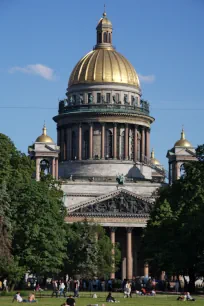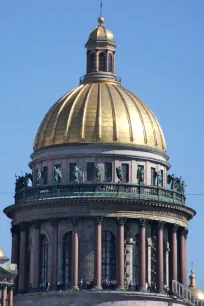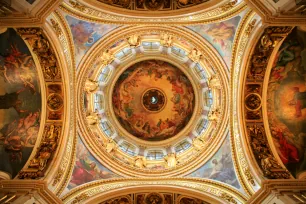St. Isaac’s Cathedral is a colossal, domed cathedral built in the nineteenth century after a design by August Montferrand. Its magnificent dome, one of the city’s most famous symbols, is visible from kilometers away.

This is the fourth church at this site dedicated to St. Isaac the Confessor, a monk who during the fourth century was imprisoned by the Roman emperor Valens. St. Isaac was eventually freed by Valens’s successor Theodosius.
His feast day is on May 30th, the birthday of Peter the Great. This was reason enough for the Russian tsar to have a church built in honor of St. Isaac. The wooden church was consecrated as early as in 1707, just four years after Peter the Great founded the city of St. Petersburg.

Construction
After the Napoleonic wars, plans were made for a new church replacing the previous eighteenth-century cathedral, which was still uncompleted. The new St. Isaac’s Cathedral was to be the most magnificent of the whole Russian Empire. Tsar Alexander I chose French architect August Montferrand to lead the project, and construction started in 1818.
The foundations of the colossal church posed serious problems, as the soil was too soft to build upon. Eventually, Montferrand used a technique which had been commonly used for centuries in Venice: thousands of wooden piles were driven into the ground to provide a solid foundation. Forty years later, in 1858, the church was completed. Montferrand died just months after completing his masterpiece.
Design
St. Isaac’s Cathedral has a Greek cross ground plan with a large central dome and four smaller domes at each corner. Four monumental porticoes supported by enormous Corinthian columns in red granite are decorated with reliefs and sculptures.
Of note is the bas-relief on the pediment of the western portico, depicting the meeting of St. Isaac with emperor Theodosius and his wife Flacilla, sculpted by Ivan Vitali. Vitali modeled Theodisius’ head after that of tsar Alexander I and Flacilla’s after that of his spouse, Elizabeth Alexeievna.

Dome
The magnificent dome of St. Isaac’s Cathedral rises to a height of 101.5 meter (333 ft.) and is visible from all over the historic center of St. Petersburg. The gleaming dome is plated with pure gold and decorated with statues of angels, sculpted by Josef Hermann. A climb to the kolonnada, the colonnade just below the dome, rewards you with a spectacular view over the city.
Interior
No expenses were spared to decorate the cathedral with the most expensive materials – fourteen different colors of marble and many semi-precious stones such as lapis lazuli and malachite were used, one of the reasons the cost of the cathedral ballooned to almost ten times that of the Winter Palace. The most renowned artists of the time, including painter Karl Briullov and sculptors Ivan Vitali and Peter Clodt, collaborated to create the most striking decorations.

Brullyov created the magnificent fresco inside the dome, depicting Maria surrounded by saints. At the center of the fresco, in the cupola at a height of about 80 meters (263 ft.) hangs a silver pigeon. The large pigeon – with a wing span of 1 meter 65 cm. – represents the Holy Spirit.
The walls of the church are decorated with magnificent frescoes and mosaics. The iconostasis is decorated with a unique stained-glass window. Above is a gilded sculpture of Christ by Peter Clodt.

